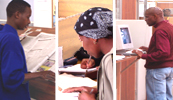
| Tips for presentations |
 |




Presenting
Presenting your presentation
 |
 |
 |
 |
 |
| Test your Presentation | Allow time before you start your presentation to test the equipment you are going to use. Familiarise yourself with the set-up so that you can focus on your presentation and not on where the next button is. Check the clarity of the content and the colours again, and make changes if necessary. | |||
 |
 |
 |
 |
 |
| Introduce yourself | Always introduce yourself and your topic, and briefly explain the process that you are going to follow with your presentation. | |||
 |
 |
 |
 |
 |
| Be professional | Your appearance (dress and grooming), the quality of your handouts and your visual presentation, etc., are very important. | |||
 |
 |
 |
 |
 |
| Timing | Start promptly and keep within your time frame. Remember to leave enough time for questions afterwards. | |||
 |
 |
 |
 |
 |
| Be enthusiastic | Be enthusiastic about your presentation and remember to smile - this will help to relieve some of the stress. | |||
 |
 |
 |
 |
 |
| Make eye contact | Remember to make eye contact with your audience. Never read your presentation - this is boring and you will lose the attention of your audience. | |||
 |
 |
 |
 |
 |
| Speaking | Speak as loudly and clearly as you can to make sure that all the members in your audience can hear your presentation. There is no point in giving a presentation if most of the audience has trouble hearing you. If you struggle to speak louder, make use of a microphone system. Don't speak too rapidly. | |||
 |
 |
 |
 |
 |
 |
Thank you |  |
At the end of your presentation, thank your audience for their time. |  |
 |
 |
 |
 |
 |
 |
 |
 |
 |
 |
